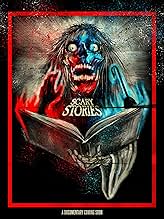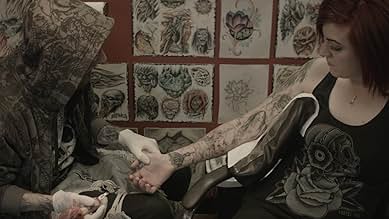A documentary about children's horror classic Scary Stories to Tell in the Dark. It includes the author's family, scholars, folklorists, artists, and children's book authors such as R.L. Sti... Read allA documentary about children's horror classic Scary Stories to Tell in the Dark. It includes the author's family, scholars, folklorists, artists, and children's book authors such as R.L. Stine, Q.L. Pearce, and more.A documentary about children's horror classic Scary Stories to Tell in the Dark. It includes the author's family, scholars, folklorists, artists, and children's book authors such as R.L. Stine, Q.L. Pearce, and more.
- Self
- (archive footage)
Featured reviews
Some two thirds of this film contain solid interviews with contributors to the book, some reputable scholars, and Schwartz's son and wife. Glimpses of the man, a truly prolific writer, and his seemingly troubled family, are moving, insightful, and a joy to watch. Some of the scholars offer powerful considerations of the thematic content of Schwartz's memorable stories, and Gammell's incredible art. This is fantastic, and make the film worth watching.
Meanwhile, the other third of the film feels wasted. First, much ado is made about the controversy the book provoked. Why do I care about what a PTA mother was thinking about a book in the 80s? I care about the books themselves.
The film is also loaded with fan interviews; a pat, badly-acted recreation and other retellings; and lesser known artists talking about how cool Scary Stories are.
For example: the film opens with a musician you've never heard of. The first four minutes of the film is dedicated to his singing a song inspired by Schwartz. Later, five minutes are dedicated to a wedding photographer recreating Schwartz's work. Schwartz' grandson--who comes across as charismatic and intelligent--leafs through Schwartz's work. This young man never knew Schwartz personally, nor does he seem to have any credential beyond being a removed relative. An interesting, though again not especially important five minutes, focuses on a sculptor reproducing Gammell's iconic Scary Stories cover. But why?
It seems these smatterings (of which there are too many) are some attempt to link Schwartz's work to those artists alive, creating, and influenced today. But these artists (save perhaps R. L. Stine, who barely talks about the titular stories) are not especially renowned And these scenes are tiresome and overlong for an 80 minute documentary, while revelations about the works themselves are touched upon in a limited way.
The final scene, a staged moment between two interesting people, is exemplary of my point. For such a momentous, impactful set of books, we find ourselves seeing Schwartz's son defending the rights of children to read Scary Stories to the censorship weilding PTA mother. While it's lovely to see a son standing up for his father, in my mind the film again misses such fertile material: the works themselves.
What this does well is helping us get to know the author, Alvin Schwartz. He had passed away so he wasn't available, which is a bummer. What I liked here though is that they interviewed his son, Peter. It sounds like they were estranged for a good stretch. This almost seems like a cathartic thing, helping him connect better with his father's lasting legacy.
Something else that I like is that this explores both sides of its impact. There is one side asking people who have been influenced to make their own art. Whether that is songs influenced, sculptures, paintings or even tattoos. There's another side though, parents wanted these books removed from libraries. They focus on one lady, who was part of the PTA, who was leading the charge in I believe Seattle. She actually participates quite a bit in this, going as far as meeting Peter. That felt a bit odd, I'll admit, especially since I don't think she ever got her lasting question resolved.
I'm not in favor of banning things. My parents took the stance that they'd police what I watched. They didn't keep most stuff from me, knowing that if they did, I'd more than likely find a way to watch it. I can see why they wanted to ban these books. Many didn't even want it outright, just not in elementary school libraries. There was a heartfelt moment where a father, whose daughter read these, was excited that she showed interest in the books. There is something to be said about finding something that interests and inspires.
I'll then end by saying that I thought this was made well enough. I can see the argument that it is a bit all over the place. It tries to jump between subjects instead of fleshing one aspect out before going to the next. That does work a bit better when dealing with a fictional narrative. It wasn't as bad listening to this while working, I'll admit that. For me, learning more about the books, their lasting legacy and their cultural impact was enough for me.
My Rating: 6.5 out of 10.
The film includes introspective pieces from R.L. Stine, Amelia Cotter, Bruce Coville and Q.L. Pearce, plus plenty of artists and writers influenced by "Scary Stories To Tell In The Dark". The real star of the documentary, and rightfully so, is the books' original artwork. Meirick guides the viewer through the three distinct topics explored in documentary nicely. The author, Mr. Shwartz, the controversy, and the legacy of the book series' influence on pop culture and horror fans. This is clearly a must for both the horror reader and anyone who's childhood included the books- especially those who maintain a love for "Scary Stories To Tell In The Dark". It is a fun, informative, and entertaining watch.
Did you know
- Quotes
R.L. Stine: Part of Alvin Schwartz's brilliance was that he took all these old folk legends and made them readable for kids. And I think that's his particular genius.
- How long is Scary Stories?Powered by Alexa
Details
- Runtime
- 1h 24m(84 min)
- Color
- Aspect ratio
- 1.78 : 1












